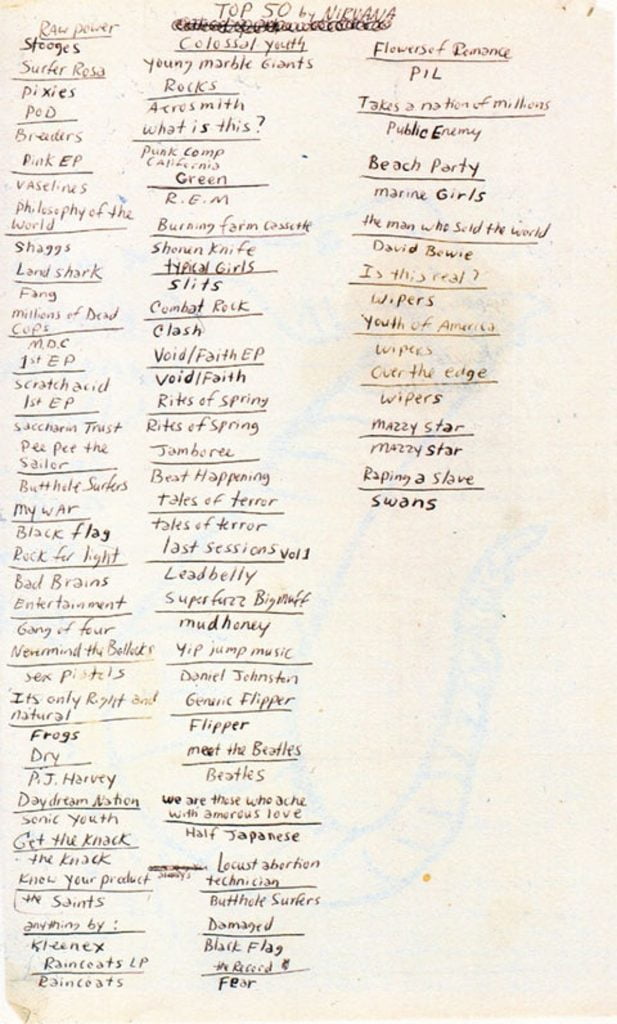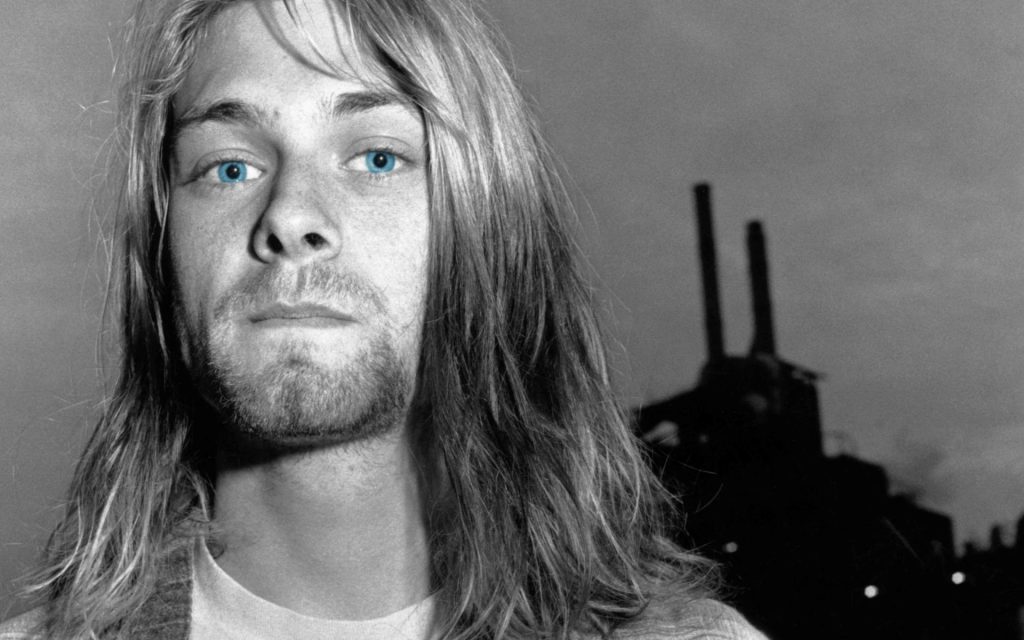Kurt Donald Cobain (February 20, 1967 – c. April 5, 1994) was an American musician whose impact on rock music reverberates today. As the lead vocalist, guitarist, and primary songwriter of Nirvana, Kurt Cobain reshaped the landscape of mainstream rock with his angsty compositions and anti-establishment ethos. Heralded as a “Spokesperson of a Generation”, he challenged societal norms through his music, influencing the trajectory of alternative rock.
In 1987 Kurt Cobain formed Nirvana with Krist Novoselic and spearheaded the Seattle music scene’s rise to prominence. With hits like “Smells Like Teen Spirit,” “Come as You Are,” and “Lithium,” Nirvana achieved unparalleled success, earning Kurt Cobain acclaim as one of the greatest songwriters of all time.
Despite his musical skills, Kurt Cobain grappled with personal demons, battling heroin addiction and depression. His tragic death in 1994 at the age of 27 cut short a career marked by brilliance and innovation. Nevertheless, his legacy is immortalized and celebrated by fans worldwide.
Kurt Cobain’s Childhood and Teenage Years

Kurt Cobain was born on February 20, 1967, at Grays Harbor Hospital in Aberdeen, Washington, to Wendy Elizabeth Cobain and Donald Leland Cobain. Raised alongside his younger sister Kimberly, Kurt’s childhood was marked by his parents’ divorce when he was nine years old, a moment that deeply impacted him. Despite the turmoil, Kurt Cobain exhibited a natural talent for art from a young age and found solace in music.
Growing up in Aberdeen, Kurt Cobain’s family had a musical background, with relatives involved in various musical endeavors. His early artistic inclinations were nurtured by his grandmother, Iris Cobain, a professional artist. Kurt Cobain’s interest in music blossomed early, and by age four, he was already playing the piano and singing.
Kurt Cobain struggled with the changing dynamics of his family, particularly after his father remarried. Witnessing domestic violence in his mother’s relationships further compounded his emotional turmoil.
Kurt’s teenage years were marked by rebellion and a search for identity. He found refuge in the Pacific Northwest punk scene, attending shows in Seattle and forming relationships with fellow musicians.
Kurt Cobain Career: Fecal Matter, Nirvana, and Other Collaborations

Kurt Cobain’s journey from a troubled youth to the forefront of rock music is a testament to his resilience and artistic vision. At the age of 14, Cobain was faced with a pivotal choice on his birthday: a bike or a used guitar. Opting for the guitar, he started to play the first songs, tackling Led Zeppelin’s “Stairway to Heaven” and AC/DC’s “Back in VBlack”, before venturing into his compositions.
In 1986, Kurt Cobain formed his first band, Fecal Matter, showcasing his raw talent alongside Melvins Drummer, Dale Crover. Despite the band’s short-lived tenure, it laid the groundwork for Cobain’s musical evolution. His path converged with Krist Novoselic, a fellow punk enthusiast and high-school friend, leading to the genesis of Nirvana in 1987.
Nirvana’s ascent was tumultuous and hard, marked by constant drummer changes and financial struggles. However, their debut album, “Bleach,” released on Sub Pop Records in 1989, laid the groundwork for their, soon, meteoric rise. Dissatisfied with drummer Chad Channing’s style, Dave Grohl entered the scene, propelling Nirvana to new heights with the release of “Nevermind” in 1991.
With the explosive success of “Smells Like Teen Spirit,” Nirvana became synonymous with the grunge movement, reshaping the musical scene of the early ’90s, and “killing” the hair metal forever. Kurt Cobain’s reluctance to embrace his newfound fame and steadfast commitment to his artistic integrity set him apart from his peers.
Despite Nirvana’s unprecedented success, Kurt Cobain grappled with inner turmoil and external pressures. His outspoken advocacy for social justice and willingness to challenge societal norms endeared him to fans worldwide. However, Kurt Cobain’s battles with addiction and health problems cast a shadow over his legacy, culminating in his tragic death in 1994.
Kurt Cobain Influences: Favorite Albums and Bands

Kurt Cobain’s musical influences spanned a wide spectrum, from his formative years, The Beatles held a special place in his heart, with Cobain fondly recalling his aunt’s gift of Beatles records. John Lennon, in particular, emerged as his idol, influencing Kurt Cobain’s songwriting and inspiring hits like “About a Girl.”
Kurt Cobain’s affinity for hard rock and heavy metal bands like Led Zeppelin and AC/DC left an indelible mark on Nirvana’s sound. The band often paid homage to these influences through live cover songs. Punk rock, introduced by Kurt Cobain’s friend Buzz Osborne of the Melvins, fueled Kurt Cobain’s rebellious spirit and artistic vision.
The Pixies were Kurt Cobain’s favorite band of all time, leading him to embrace a more melodic approach evident in albums like “Nevermind.” Sonic Youth and R.E.M. served as mentors, guiding Nirvana through the complexities of the music industry.
Even amidst mainstream success, Kurt remained loyal to indie bands, by featuring them on Nirvana’s albums or covering their songs in live performances. His reverence for artists like Lead Belly (“Where Did You Sleep Last Night“) and David Bowie (“The Man Who Sold The World“) demonstrated his appreciation for raw emotion and authentic storytelling, for whom he paid homage with two songs on the legendary MTV Unplugged album.
Kurt Cobain’s Guitars

Credit: smh
Kurt Cobain’s guitars played a significant role in shaping his iconic sound and image. Despite his preference for budget-friendly options, Cobain’s guitars became emblematic of his distinctive style.
Starting with his first guitar, a used electric Sears model received on his 14th birthday, Cobain’s instrument collection grew over time. He often struggled to find quality left-handed guitars, leading him to modify right-handed models for his use.
Among his notable guitars were various Fender models, including Jaguars, Stratocasters, and a Mustang, which he customized to suit his playing style. These guitars, paired with modest amplifiers and effects pedals, contributed to the raw, gritty sound that defined Nirvana’s music.
Perhaps the most renowned of Kurt Cobain’s guitars is his 1959 Martin D-18E acoustic, famously used in Nirvana’s MTV Unplugged performance. This guitar, modified for left-handed playing, fetched record-breaking prices at auction (sold at auction for over $6 million).
Kurt Cobain’s Relationships, Sexuality, Health, and Addiction

Kurt Cobain’s personal life was a complex web of relationships, sexuality exploration, and health struggles, all of which left an indelible mark on his music.
Before Courtney Love, Kurt Cobain dated Tracy Marander, with whom he shared a significant three-year period in Olympia from 1987 to 1990. Marander’s influence is evident in songs like “About a Girl,” reflecting their shared experiences and Cobain’s emotional depth.
Tobi Vail, another pivotal figure in Kurt Cobain’s life, had a brief but intense four-month relationship with him in 1990. Tobi Vail’s impact reverberated throughout Nirvana’s iconic “Nevermind” album, shaping its themes and alleviating the depression Kurt Cobain suffered after their breakup.
Despite these romantic entanglements, Cobain’s sexuality remained fluid, with expressions of attraction to both men and women. He openly challenged societal norms and advocated for LGBTQ+ rights, aligning himself with the gay community.
Cobain’s struggles extended beyond relationships, encompassing chronic pain, depression, and addiction. His battles with heroin addiction were well-documented, culminating in near-fatal overdoses that cast a shadow over Nirvana’s performances.
The Tragic End of a Music Icon: Suicide and Aftermath

Kurt Cobain’s untimely death marked the tragic conclusion of a troubled life plagued by addiction, illness, and emotional turmoil. On April 8, 1994, Cobain’s lifeless body was discovered at his Lake Washington Boulevard home, the victim of a self-inflicted gunshot wound. He was just 27 years old.
The events leading up to Kurt Cobain’s death were fraught with despair and desperation. Despite intervention attempts by loved ones, including a detox program and residential treatment, Cobain’s battle with heroin addiction persisted. His marriage to Courtney Love was marred by tumult, and his mental state deteriorated rapidly.
The discovery of Kurt Cobain’s suicide note, addressed to his childhood imaginary friend Boddah, offered a glimpse into his tortured psyche. Quoting Neil Young’s lyrics, “It’s better to burn out than to fade away,” Cobain expressed his disillusionment with fame and the music industry, longing for the creative spark he had lost.
Kurt’s death sent shockwaves through the music world, prompting an outpouring of grief from fans and fellow musicians. Vigils were held in his honor, and sales of Nirvana’s music skyrocketed after his death.
Three decades later, the circumstances surrounding Kurt Cobain’s death continue to spark debate and speculation. Despite official rulings of suicide, questions linger, with ongoing requests to reopen the investigation. Cobain’s legacy endures as a cautionary tale of the perils of fame, addiction, and mental illness, serving as a reminder of the fragility of life.
After The Experience: Woodstock and Band of Gypsys
Kurt Cobain’s legacy reverberates as one of the most influential figures in alternative rock. His raw, angst-ridden songwriting and rebellious persona made him the voice of Generation X. Kurt Cobain’s music expanded the boundaries of mainstream rock, delving into themes of personal reflection and societal critique.
Inducted into the Rock and Roll Hall of Fame in 2014, Cobain’s impact on music transcends his untimely death at 27 years old, placing him among the infamous “27 Club.” His authenticity resonated deeply with fans and fellow musicians, cementing his status as a cultural icon.
From memorial parks to annual tribute days, Cobain’s memory lives on in the hearts of his admirers, young, old, and new fans to come.









